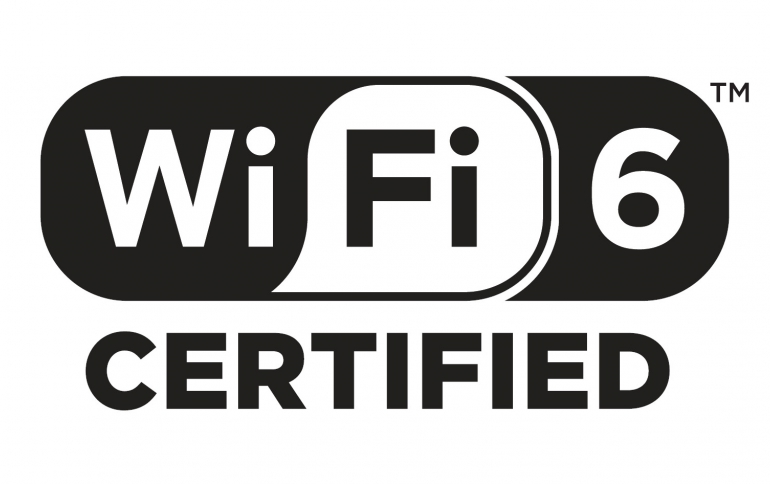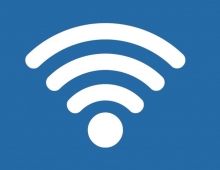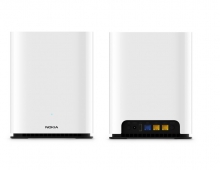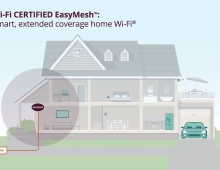
Wi-Fi 6 Certification Marks Evolution in Delivery of Wi-Fi Connectivity
The Wi-Fi CERTIFIED 6 certification program from Wi-Fi Alliance is now available for devices based on IEEE 802.11ax.
The certification program brings new features and capabilities that enable greater overall Wi-Fi network performance in challenging environments with many connected devices such as stadiums, airports, and industrial parks. Wi-Fi CERTIFIED 6 provides capacity, performance, and latency improvements to the entire Wi-Fi ecosystem, while ensuring products across vendors to work well together.
Wi-Fi 6 will operate in the 2.4 and 5 GHz bands.
The Wi-Fi CERTIFIED 6 supports a more diverse set of devices and applications, from those requiring peak performance in demanding enterprise environments to those requiring low power and low latency in smart homes or industrial IoT scenarios. Wi-Fi CERTIFIED 6 delivers nearly four times the capacity of Wi-Fi 5, and is an advancement for Wi-Fi’s ability to deliver high-performance infrastructure and optimized connectivity to all devices on a network simultaneously. Wi-Fi CERTIFIED 6 delivers critical connectivity that supports cellular networks, and leverages high speeds, low latency, power efficiency, greater capacity, and enhanced coverage to deliver many advanced 5G services.

Wi-Fi CERTIFIED 6 also delivers security protocols and requires the latest generation of Wi-Fi security, Wi-Fi CERTIFIED WPA3. Capabilities available in Wi-Fi CERTIFIED 6 include:
- Orthogonal frequency division multiple access (OFDMA): effectively shares channels to increase network efficiency and lower latency for both uplink and downlink traffic in high demand environments
- Multi-user multiple input multiple output (MU-MIMO): allows more downlink data to be transferred at once and enables an access point to transmit data to a larger number of devices concurrently
- 160 MHz channels: increases bandwidth to deliver greater performance with low latency
- Target wake time (TWT): significantly improves battery life in Wi-Fi devices, such as Internet of Things (IoT) devices
- 1024 quadrature amplitude modulation mode (1024-QAM): increases throughput in Wi-Fi devices by encoding more data in the same amount of spectrum
- Transmit beamforming: enables higher data rates at a given range resulting in greater network capacity
OFDMA allows Wi-Fi CERTIFIED 6 to support many devices at the same time, and to diminish the interference that causes congestion in Wi-Fi networks today. A major factor limiting current Wi-Fi is collisions: when multiple devices transmit at the same time and interfere with each other. With OFDMA, each slice of spectrum is separated into many smaller sub-channels, each with a slightly different frequency. Rather than waiting in line for their turn to transmit across the whole frequency channel, multiple devices will be able to share the channel simultaneously to increase overall network capacity and throughput. OFDMA adds flexibility to how spectrum is used, only allocating parts of the spectrum to each wireless device proportional to its needs.
Additionally, Uplink-OFDMA may be one of the most important features of Wi-Fi CERTIFIED 6. Uplink-OFDMA reduces collisions and overhead, improving the performance of the network. This feature keeps the traffic traveling in both directions from colliding, and results in robust Wi-Fi networks capable of scheduling wireless traffic efficiently.
Uplink-OFDMA also increases the range of Wi-Fi networks. This is because it solves a problem that exists today - Wi-Fi connections are asymmetrical. Access points (APs) have more range than mobile devices. APs are usually plugged in to a power source, and hence, battery life is less of a concern. This allows them to transmit at a higher power than mobile devices. Meanwhile, mobile phones need to optimize battery life and transmit less power than their infrastructure counterparts. This limits the range of a Wi-Fi user because the phone cannot reach the AP, whereas the AP can reach the phone. With Wi-Fi CERTIFIED 6, the phone can concentrate its energy in a narrower channel – as narrow as 2 MHz – and reach the AP by boosting the peak power transmitted while remaining compliant with spectrum regulations. This feature solves the link budget asymmetry (as much as 10 dB) in legacy Wi-Fi which can double the communication range, reduces dead spots, and improves Wi-Fi performance for users, enterprises, mobile carriers, and internet service providers alike.
Samsung announced that the Samsung Galaxy Note10 is the first Wi-Fi CERTIFIED 6 smartphone, and Wi-Fi Alliance expects most leading phones and access points will soon support the latest generation of Wi-Fi. The first products designated Wi-Fi CERTIFIED 6 which comprise the test bed for certification include:
- Broadcom BCM4375
- Broadcom BCM43698
- Broadcom BCM43684
- Cypress CYW 89650 Auto-Grade Wi-Fi 6 Certified
- Intel Wi-Fi 6 (Gig+) AX200 (for PCs)
- Intel Home Wi-Fi Chipset WAV600 Series (for routers and gateways)
- Marvell 88W9064 (4x4) Wi-Fi 6 Dual-Band STA
- Marvell 88W9064 (4x4) + 88W9068 (8x8) Wi-Fi 6 Concurrent Dual-Band AP
- Qualcomm Networking Pro 1200 Platform
- Qualcomm FastConnect 6800 Wi-Fi 6 Mobile Connectivity Subsystem
- Ruckus R750 Wi-Fi 6 Access Point





















